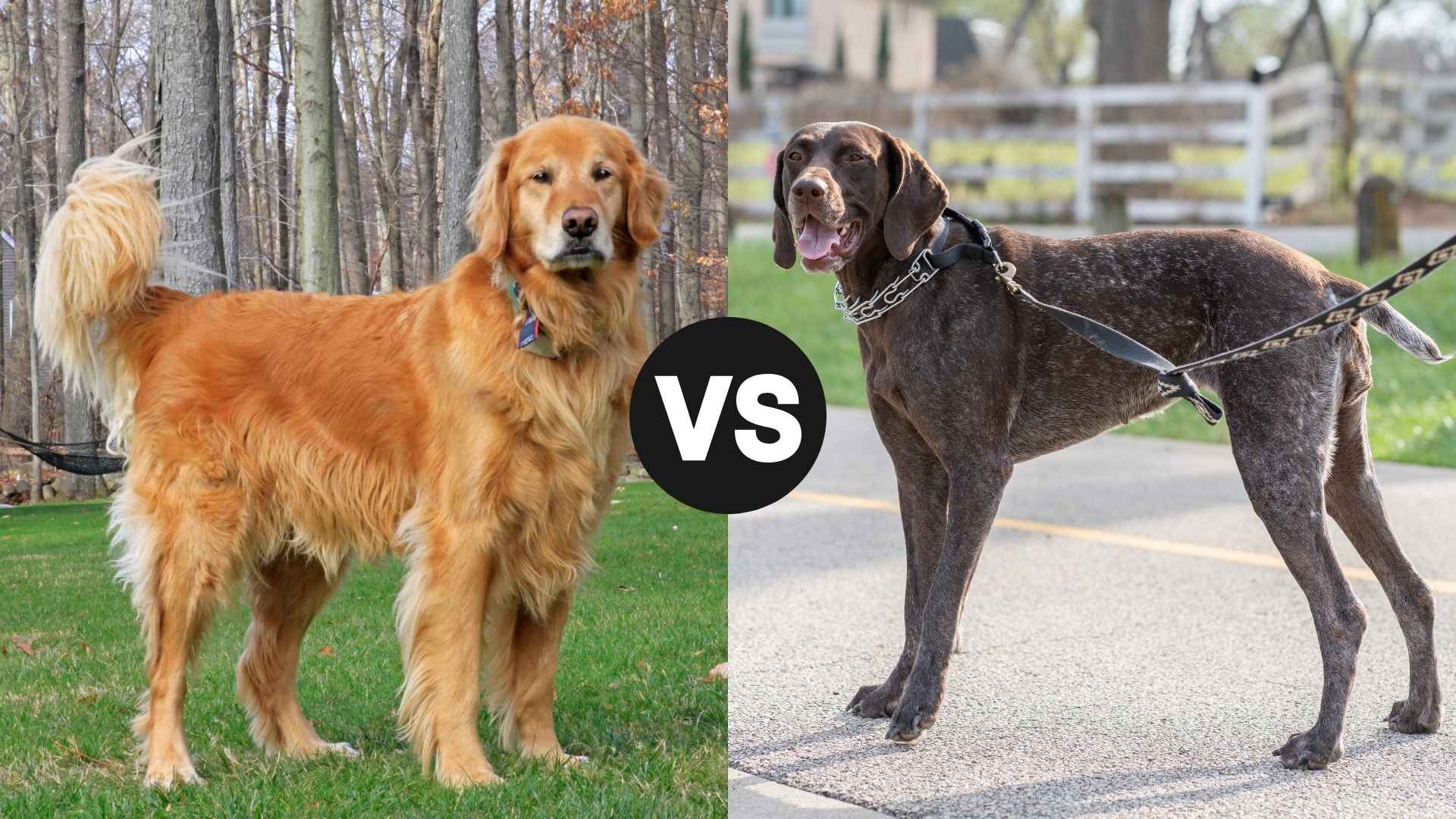The Golden Retriever bounds up with a tennis ball, tail swishing like a happy flag. The German Shorthaired Pointer stands alert, body tense with energy, ready to sprint.
Two amazing dogs with two very different stories. The Golden, a family favorite for years, brings sunshine wherever it goes. The Pointer, built for the hunt, mixes keen senses with non-stop drive.
Both wear the crown of “top dog” in many homes across the world, but for very different reasons. One thrives on love and hugs, the other on tasks and trials.
Are you looking for your next four-legged family member? Or just curious about these popular breeds? Let’s walk through what makes each one tick – from their coat care to their exercise needs, their health to their happiness. Your perfect dog match might be waiting in these pages.
Golden Retriever vs. German Shorthaired Pointer
Physical Appearance and Size
Build and body structure
Golden Retrievers have a sturdy, balanced frame — not bulky, but broad through the chest and strong in the legs. Males typically stand 23–24 inches tall and weigh 65–75 pounds, while females are slightly smaller. Their posture carries a natural grace that pairs well with their gentle demeanor.
German Shorthaired Pointers (GSPs), on the other hand, have a more athletic and streamlined appearance. They’re built for endurance and speed, with long legs, a tucked abdomen, and noticeable muscle definition. Males range from 23–25 inches and weigh 55–70 pounds, while females often fall between 45–60 pounds.
Coat and coloring
Golden Retrievers are instantly recognizable thanks to their flowing double coat that ranges from pale cream to deep gold. The outer coat is water-repellent with feathering on the chest, legs, and tail, as highlighted by Pawlicy Advisor. Shedding is moderate to high, especially during seasonal transitions.
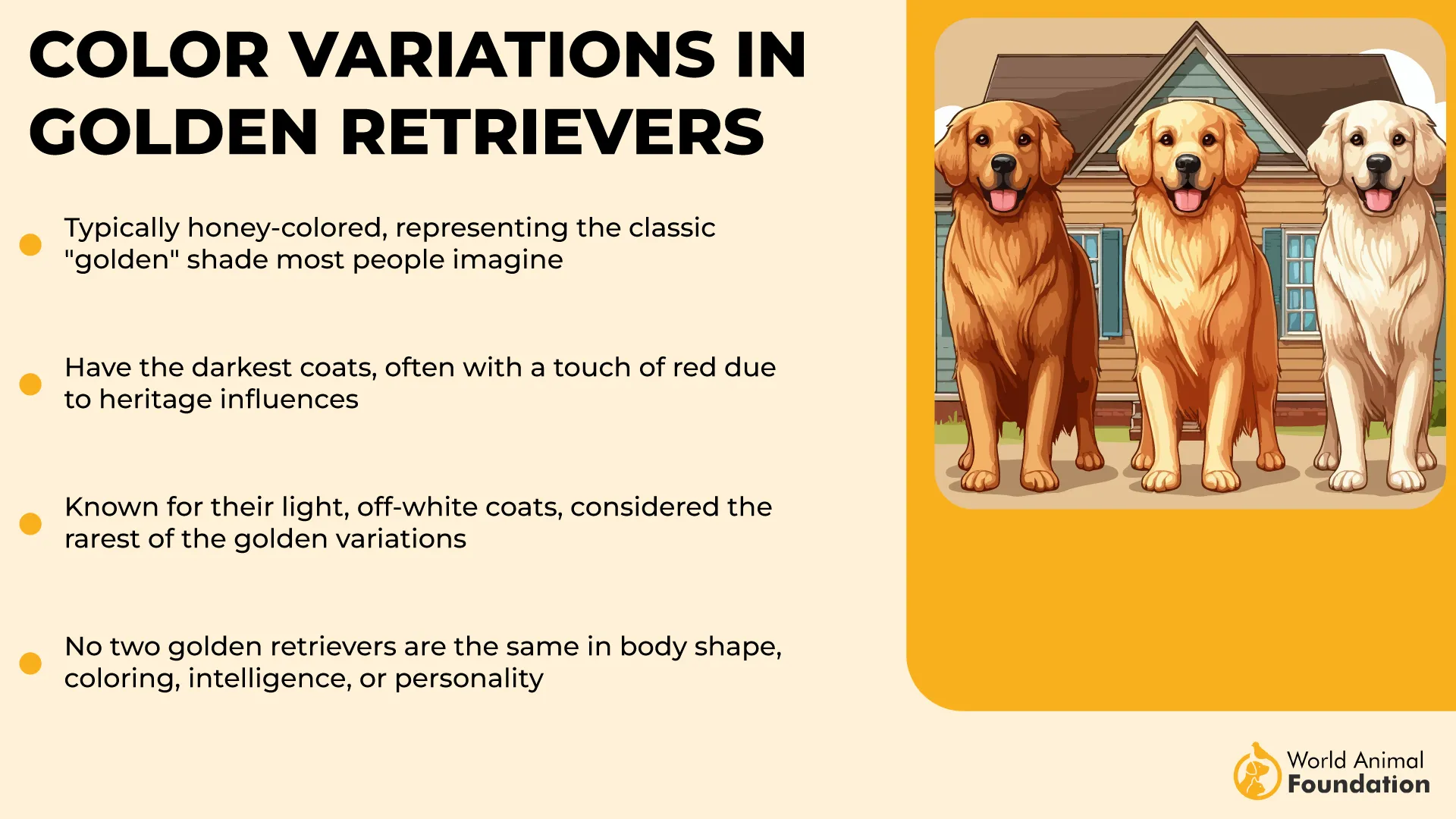
GSPs sport a short, dense coat that lies flat and requires far less grooming. According to PetMD, their coloring is typically liver (a deep reddish brown), liver and white, or ticked. This low-maintenance coat makes cleanup easier and contributes to their lean look, one of their most distinct characteristics.
Facial features and overall vibe
Goldens have a broad head, kind eyes, and soft expression — part of the emotional characteristics that draw families in. Their thick ears hang loosely at cheek level, giving them a perpetually friendly face.
In contrast, GSPs have a sharper, more defined facial structure, with almond-shaped eyes and ears set high and close to the head. Their physical attributes suggest focus and drive, which matches their working-dog mentality.

Side-by-side impression
While both belong to beloved dog breeds, they differ vastly in appearance. Goldens exude softness and sociability, while GSPs give off a lean, kinetic energy. Each has evolved for different functions — one as a retriever, the other as a hunter — and that shows clearly in their characteristics and build.
Temperament and Behavior
Golden Retriever: calm, affectionate, and always social
Golden Retrievers are famously gentle and people-oriented. They have a friendly and outgoing nature that makes them eager to greet strangers and melt into family life. Goldens are emotionally in tune — they often sense moods, adjusting their energy accordingly, whether it’s playtime or downtime.
They’re known as excellent family pets for a reason. Patients with kids, tolerant of chaos, and not easily rattled, their steady temperament adds a layer of calm to any home environment. Their strong desire to please is also what makes them so trainable — they want to get it right, and they want your praise.
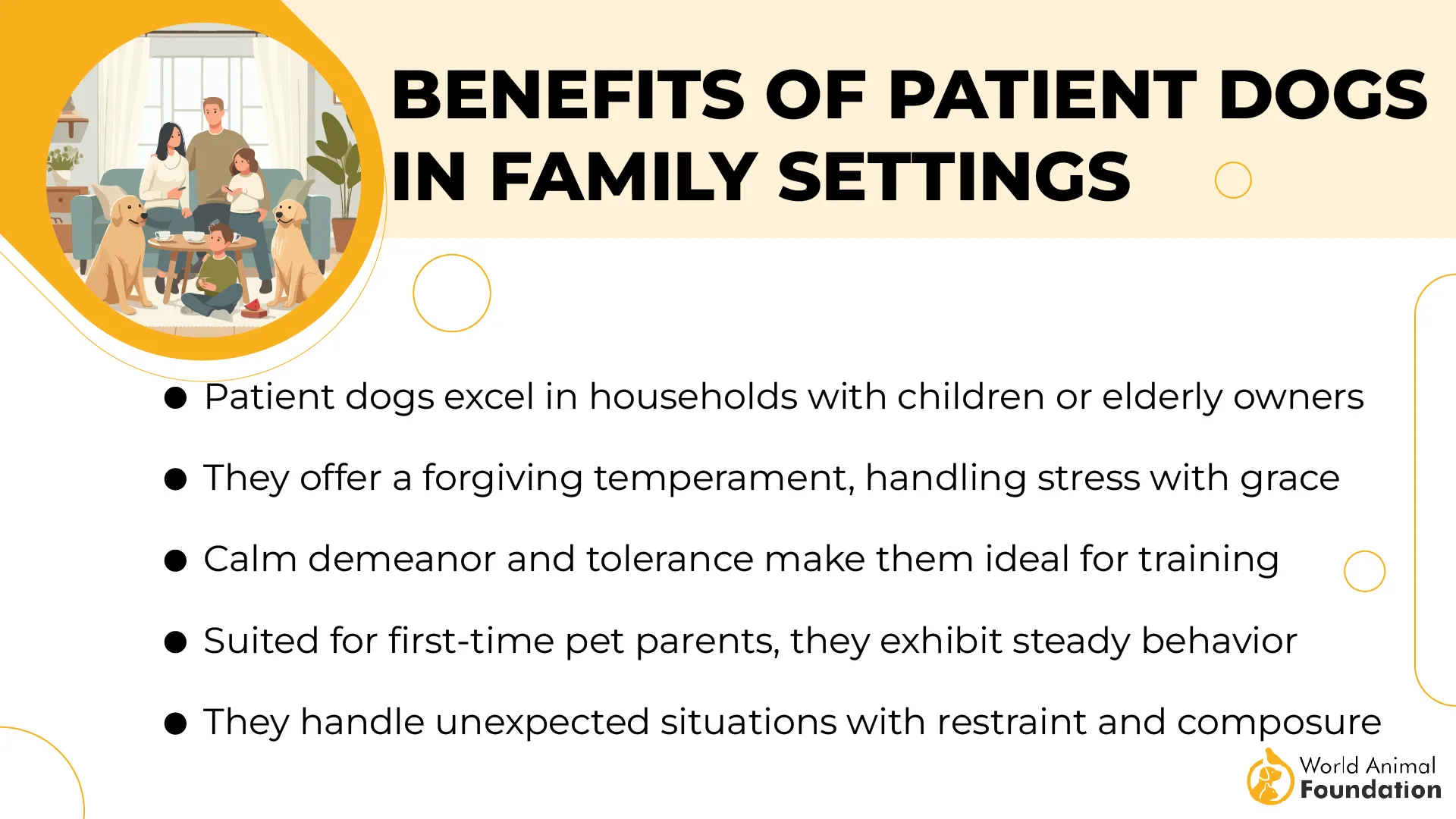
German Shorthaired Pointer: energetic, alert, and people-loving
GSPs are often described as loyal shadows. They thrive on human interaction and are known for forming strong bonds with their families. While slightly more intense than Goldens, they’re still incredibly social and make great companions, especially for active households.

Their temperament leans more toward high-energy curiosity. This means they need regular mental and physical outlets, or they might channel their intelligence into less helpful behaviors. With proper stimulation, they’re affectionate and highly involved in family routines.
Interaction with others
Both breeds are ideal family dogs, but their expression of affection differs. As per PDSA, Goldens are more laid-back cuddlers; GSPs show love through action and enthusiasm.
They also generally get along well with other pets, especially when socialized early. That said, a GSP’s hunting instincts may kick in with small animals, so supervision is important.
Emotional needs
Neither of these breeds is content being left alone for long. Their emotional well-being is closely tied to human connection. If you’re not home much, both breeds may develop separation-related behaviors, especially GSPs, who crave daily engagement and variety.
Intelligence and Trainability
Golden Retriever: eager learners with emotional intelligence
Golden Retrievers are often celebrated for being highly trainable, not just because they’re smart, but because they’re emotionally intuitive and deeply motivated to please. Their ability to read human cues makes them exceptional in therapy roles, service tasks, and even search-and-rescue work, as stated in Purina.

What truly sets Goldens apart is their patience. They’re not just quick to learn, but consistent, even in distracting environments. You can teach them advanced commands or more subtle social behaviors, and they’ll deliver with reliability.
German Shorthaired Pointer: quick, sharp, and easily bored
GSPs are also brilliant — just in a slightly different way. Their intelligence leans toward independence and quick decision-making. Originally bred to hunt across terrains without constant human guidance, they’ve developed strong instincts and fast processing.
However, this intelligence comes with one big condition: constant mental stimulation. A bored GSP can easily outsmart basic obedience routines, so training needs variety. They respond well to games that involve problem-solving or reward-based learning with a challenge.
Training approach matters
Both breeds are smart, but they thrive under different teaching styles. Goldens respond beautifully to consistency and praise. GSPs need structured tasks that engage their minds and allow freedom within boundaries — otherwise, they’ll create their own “jobs” around the house.
Exercise Requirements and Energy Levels
Built to move — and keep moving
Golden Retrievers and German Shorthaired Pointers are both high-energy dogs, but their needs aren’t interchangeable. Goldens do well with moderate yet consistent activity: long walks, fetch sessions, and swims are their sweet spot. For them, regular exercise helps maintain weight and behavior, but doesn’t have to be intense.

GSPs, meanwhile, are built for endurance. They’re not just energetic — they’re relentless. Bred to cover ground in open fields, they need significantly more physical and mental engagement. A walk around the block won’t cut it. We’re talking extended runs, agility work, and frequent outdoor activities like hiking or field games.
Matching energy to the environment
For active owners, GSPs are dream dogs. They’ll match your pace and ask for more. But without outlets, they can become anxious or destructive. Goldens, while active, are more forgiving if a day or two gets lighter, as long as they’re included in your daily routine.
Why this matters
Training success, behavior, and emotional health are tied to energy output. For GSPs, exercise isn’t just physical — it’s mental. Without layered mental stimulation, they can become hyper-focused on their surroundings or develop compulsive behaviors.
In contrast, Goldens use movement to connect with people. Their exercise also serves their need for companionship, making it a bonding experience.
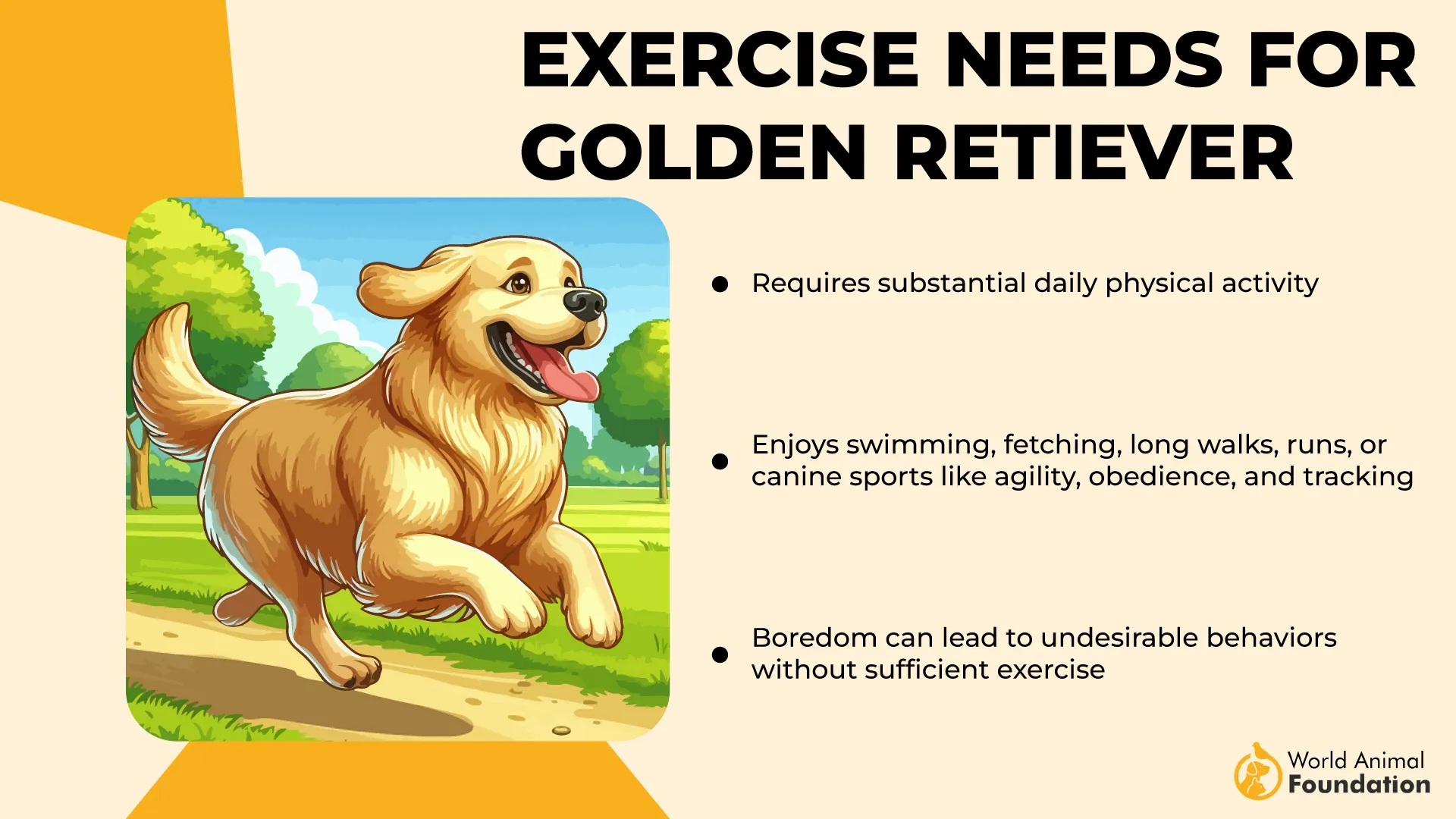
The role of structure
When choosing between these two, consider various factors: your time, space, and lifestyle. Each dog benefits from regular exercise, but the intensity, frequency, and emotional payoff differ, and getting it right helps prevent boredom, frustration, and long-term stress in both.
Health, Lifespan, and Common Medical Issues
Golden Retriever: longevity with genetic concerns
Golden Retrievers typically live around 10–12 years, though this can vary based on genetics and lifestyle. One of the most pressing health concerns in this breed is cancer. According to research, nearly 60% of Golden Retrievers are impacted by some form of cancer, including hemangiosarcoma and lymphoma.
Other notable health issues include hip and elbow dysplasia, hypothyroidism, and skin allergies. Eye conditions like cataracts and progressive retinal atrophy may also appear with age. Early health screening is essential, especially for joints and the heart, if you want to make an informed decision before bringing one home.
Their popularity has led to overbreeding in some cases, which means reputable breeders with strong health testing practices are crucial.
German Shorthaired Pointer: athletic and generally sturdy
GSPs often live slightly longer, averaging 12–14 years. They’re regarded as a healthy breed overall, but are not without their own risks. Hip dysplasia is a shared concern with Goldens, and GSPs may also experience entropion (a condition where the eyelid rolls inward), gastric torsion (bloat), and Von Willebrand’s disease — a clotting disorder.
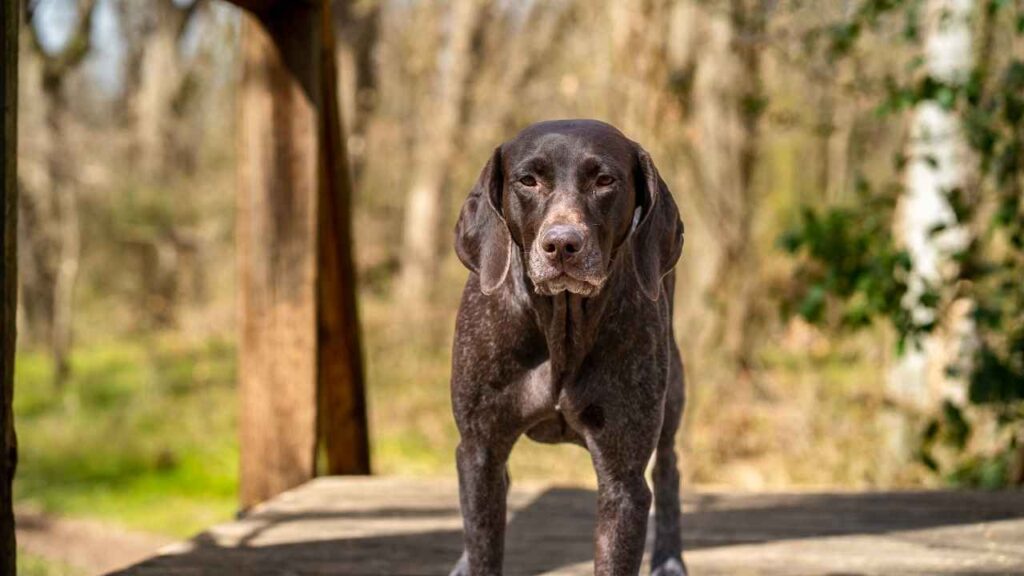
Because of their active nature, sports injuries and overuse of joints can become issues if they’re not given enough rest or proper exercise balance.
Comparison to other breeds
Compared to many other dogs, both Goldens and GSPs have relatively average lifespans for their size, but Golden Retrievers face more documented long-term health concerns. GSPs benefit from fewer hereditary diseases but do require diligent care to manage their high energy safely.
Preventive vet care, diet, and responsible breeding practices can all tip the scales when it comes to keeping either breed healthy into their senior years.
Choosing the Right Breed for Your Lifestyle
If your routine leans relaxed, and you enjoy calm walks, family hangouts, and a companion that adapts easily to downtime, the Golden Retriever fits naturally into that pace. They’re affectionate, steady, and love being around people, no matter the age.

If your lifestyle is more active, with frequent hikes, runs, or outdoor adventures, the German Shorthaired Pointer will keep up and then some. They thrive in busy, high-energy homes where they’re part of the action every day.
Both are loyal and people-loving, but their energy levels and mental stimulation needs are very different. Matching their temperament to your day-to-day life is the difference between a happy dog and a stressed one.
Conclusion
So there you have it – two breeds that couldn’t be more different, yet both amazing in their own ways. The Golden with its water repellent double coat needs more brushing, while the GSP’s short coat means minimal grooming for busy owners.
Think about your activity level honestly. Do you enjoy outdoor activities every single day? The GSP might be your match. Want a calm buddy for apartment living? The Golden adapts better to smaller spaces.
Both will bring joy to your home, but in very different ways. The Golden spreads calm happiness everywhere it goes. The GSP adds exciting energy to every moment. Among pointing dogs, the GSP stands out for its drive and focus.
But the Golden is well suited for families who want love without the high-energy demands. Your perfect dog is out there – you just need to pick the right fit for your life.


